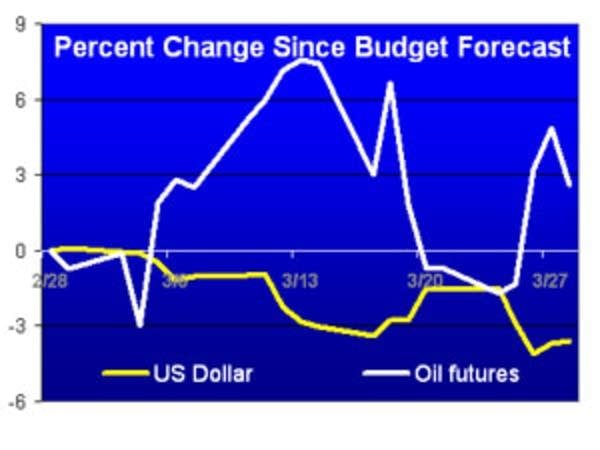How do changing economic factors affect the state's budget forecast?

State lawmakers are still trying to erase a $935 million budget deficit. A number of committees have looked at the issue, including the Senate Finance Committee, which took a stab at it on Friday.
That nearly-billion dollar figure is based on the state's most recent budget forecast, which came out in February.
But in the weeks since the state's forecast came out, oil spiked and the dollar plunged.
Amidst that changing picture, a firm called Global Insight updated one of its own forecasts.
Create a More Connected Minnesota
MPR News is your trusted resource for the news you need. With your support, MPR News brings accessible, courageous journalism and authentic conversation to everyone - free of paywalls and barriers. Your gift makes a difference.

That's key because a lot of Minnesota's own state forecast is based on numbers from the national forecaster.
Global Insight changed its oil forecast, saying that prices would probably stay higher for longer than previously predicted.
Energy expert Mary Novak cites the fall of the U.S. dollar as one reason for changing those oil numbers.
"The single-biggest thing is that the currency outlook is still falling, so as long as it continues to fall, you'll have commodities stay high," Novak said.
So if the state relied on Global Insight's numbers to come up with a deficit of $935 million, and then some of the firm's numbers changed, shouldn't that $935 million number change, too?
And what about all that other news that's hit the stands since the state's forecast came out?
Payrolls shrank by 63,000 jobs, much worse than expected. Consumer confidence fell this month much more than experts had forecast.
What are the implications for the state budget?
"That's really just noise," said State Economist Tom Stinson.
Stinson prepares and presents those state reports twice a year, in February and in November.
"Unless there's something very important and very big going on, we would not revise the forecast until the next regularly-scheduled forecast because there's enough variation and stuff," Stinson added.
Stinson said oil forecasts are one of a number of factors that affect the state's outlook. He argues the credit crunch and consumer spending are much more pressing.
But at least one high-ranking state lawmaker thinks two forecasts a year aren't enough, especially when the economy seems so volatile.
"In the past what we've done a couple times is have interim budget forecasts to try to see if there ought to be some kind of needed corrected action," said Sen. Dick Cohen, DFL-St. Paul, who chairs the Finance Committee.
But state economist Tom Stinson said an interim forecast isn't practical. For one, he still thinks $935 million is still a good estimate.
Secondly, he said there wouldn't be much point in doing a new forecast now because Global Insight will revise its economic outlook on April 8. So why update things now if the numbers are about to change anyway?
And that's not the only logistical problem.
"It takes us on the order of three to four weeks to do a forecast, of long days and nights because we have to put a lot of numbers together to come up with estimates of what's going to happen," Stinson said.
That's not to say lawmakers are totally in the dark. Stinson and the Finance Department issue quarterly revenue updates that aren't as in-depth as the twice-yearly budget forecasts.
The next one is due April 10.
